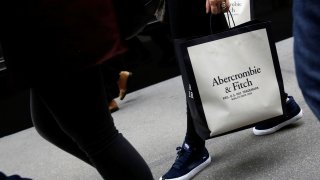
- Abercrombie & Fitch reported an unexpected loss for its fiscal first quarter, with freight and product costs weighing on sales.
- The apparel retailer also slashed its sales outlook for fiscal 2022, anticipating that economic headwinds will remain at least through the end of the year.
- CEO Fran Horowitz said the retailer will manage its "expenses tightly" and search for opportunities to offset the higher logistics costs in the near term.
Abercrombie & Fitch shares fell 29% Tuesday after the retailer reported an unexpected loss for its fiscal first quarter, with freight and product costs weighing on sales.
Abercrombie also slashed its sales outlook for fiscal 2022, anticipating that economic headwinds will remain at least through the end of the year. The news sent shares of apparel retailer American Eagle Outfitters down 6%, and Urban Outfitters down about 8%.
Abercrombie now sees revenue to be flat to up 2%, compared with its earlier forecast of 2% to 4% growth. Analysts were looking for a year-over-year increase of 3.5%, according to Refinitiv consensus estimates.
We're making it easier for you to find stories that matter with our new newsletter — The 4Front. Sign up here and get news that is important for you to your inbox.
CEO Fran Horowitz said in a statement that the company will manage its expenses "tightly" and search for opportunities to offset the higher logistics costs in the near term. She said Abercrombie plans to keep investing in marketing, technology and customer experiences.
Abercrombie joins a growing list of retailers -- including Walmart, Target and Kohl's -- that are seeing profits take a hit as inflation hovers at a 40-year high. There are also concerns that inventories are beginning to pile up, following months of supply chain backlogs, just as consumer demand for certain products is waning. That could force companies like Abercrombie to discount items to move them off shelves.
Here's how Abercrombie did for the three-month period ended April 30, compared with Wall Street expectations, based on Refinitiv estimates:
- Loss per share: 27 cents adjusted vs. earnings of 8 cents expected
- Revenue: $813 million vs. $799 million expected
Abercrombie reported a net loss for its fiscal first quarter of $14.8 million, or 32 cents per share, compared with net income of $42.7 million, or 64 cents a share, a year earlier.
Money Report
Excluding one-time items, Abercrombie lost 27 cents per share. Analysts had expected the company to earn 8 cents a share during the quarter.
Sales rose 4% to $812.8 million from $781.4 million a year earlier. That was more than the $799 million Wall Street expected.
That reflected a 3% drop in sales for its Hollister banner. Sales of its namesake label rose 13%.
The company noted that its Abercrombie brand had its strongest-ever swim business in a first quarter, a sign that consumers have been buying swimsuits for long-awaited vacations, even during the cooler months.
But Abercrombie's inventories ballooned to $563 million as of April 30, up 45% from a year ago. The company said it bulked up inventories partly to guard against potential supply chain disruptions going forward, especially around the back-to-school and holiday shopping periods that are critical for retailers.
In a phone interview, Horowitz told CNBC that Abercrombie is preparing for a "much more normalized" back-to-school shopping season after the pandemic kept many students at home the past couple years.
"We're giving ourselves more time to get our goods here, so we're prepared and we have our in-stock [levels] where we want them to be," she said.
The retailer cut its outlook for fiscal-year operating margins to a range of 5% to 6%, down from a prior range of 7% to 8%. Abercrombie said the adjustment takes into account higher freight and raw material costs, foreign currency and lower sales due to an assumed inflationary impact on consumers.
Beginning in the second quarter, Abercrombie said it will no longer provide full-year or quarterly outlooks on gross profit rate or operating expenses, "in response to volatility in freight and other costs."
Abercrombie shares closed Tuesday down 29% at $19.09, marking their largest percentage decrease on record. The stock has fallen about 45% year to date, including those losses.






